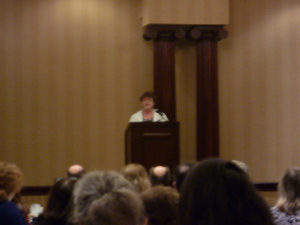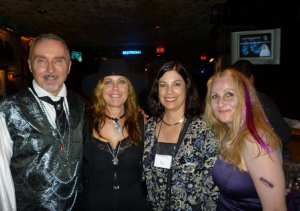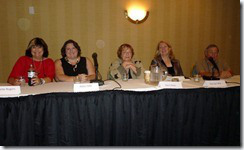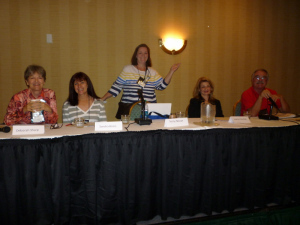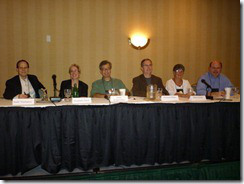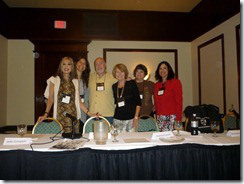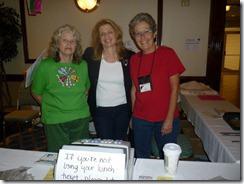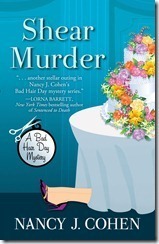Nancy J. Cohen's Blog: Nancy's Notes from Florida, page 107
March 12, 2012
Charlaine Harris
Sleuthfest: Part 5
Charlaine Harris
Charlaine Harris began her keynote speech by giving an entertaining description of her typical day and all the requests she fields. She discussed how her writing schedule has changed and how the publishing industry has altered in the past ten years. It's a challenge to agents and publishers as contract negotiations have changed forever. The traditional model may be going the way of the dinosaurs. The difference between traditionally published books in the bookstore and self-published e-books is editing. And to conclude, "All books benefit from editing."
Indie editors are on the rise. Some are professional; others take advantage of newbie authors. So while e-books are here to stay, they bring along a lot of baggage. Regarding TV/film sales: Be prepared to concede certain rights or walk away from the deal. Charlaine says that when people meet an author, right away they demand to know if you've sold to TV or the movies. Writers are in the entertainment industry. We want to deliver our books to readers anyway we can, even if it's an e-book carried in your purse. Her advice to aspiring authors: "Read, read, read. Put your butt in the chair and write."
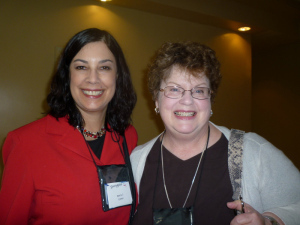
Nancy Cohen and Charlaine Harris
Does Your Muse Need A Makeover?
Lisa Unger, Peter Abrahams, and Julie Kramer, with Elaine Viets moderating.
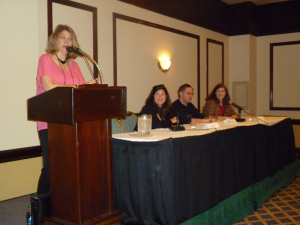
Lisa began by stating how her first publisher turned down her option book, but she was lucky that another publishing house picked it up. Peter reinvented himself as a YA author. And then he wrote a first-person story from a dog's viewpoint. His agent suggested he take on a pen name when he started writing with broader humor within the crime fiction genre. Julie's work got darker over time. She'd already been orphaned by her first publisher. Afraid her current publisher was about to cancel the series, she killed off a significant character. It shook the series up. Peter advises authors to "Have the story come out of you rather than following the latest trend. Find that unique part of you and blow it up." Lisa says, "Have respect for your own voice." And Julie wished that she'd changed from journalism to writing fiction a lot sooner.
Stretching Credibility
Marcia Talley, Mary Ann Evans, Nancy Cohen, Julie Kramer, moderated by Bob Williamson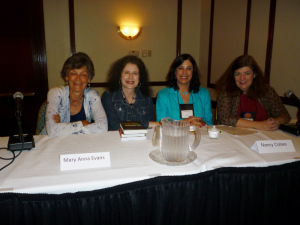
We discussed how we keep our characters real in the midst of absurdity, like dead bodies popping up everywhere in amateur sleuth stories. We talked about the daily news as a source of tales stranger than fiction, and how we might use humor to involve our sleuth in "over the top" situations or as a behavior to mask uncertainty. Grounding the stories are the sleuth's personal relationships.
Saturday evening, we enjoyed the Sleuthfest cocktail party with appetizing hors d'oeuvres and a cash bar. This gave attendees the opportunity to mingle with editors and agents in a social setting. Following was bestselling author Heather Graham's dinner party at Disney's House of Blues. The food was amazing and the entertainment—with Heather as vocalist and MWA members in the band—was lively. People danced and chatted and it was great fun. Many thanks to Heather for her generosity in sponsoring this event!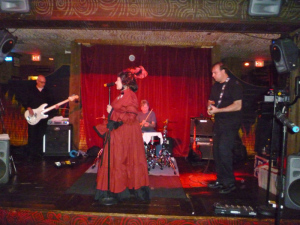
Michael Meeske, Kathleen Pickering, Nancy Cohen, Traci Hall
You can view my Sleuthfest 2012 Photo Album on my Facebook Author Page. Please "Like" the page while you're there!
Sunday morning wrap sessions and a discussion with the keynote speakers ended the conference, but I skipped out to go to the Florida Strawberry Festiveal in Plant City.
Coming Tuesday: Guest Blogger and Mystery Author Camille Minichino








March 11, 2012
Editors Roundtable
Sleuthfest: Part 4
Editors Roundtable
Annette Rogers from Poisoned Pen Press said unagented submissions are okay and they are looking for new, unpublished authors. They do mysteries only, not thrillers. Some of their bestselling books are historicals. They have 120 writers. They're running a contest for previously unpublished mystery authors, so check it out. There's a $1000 prize and a quick response. Otherwise, submissions may take 2 to 3 months for a response. She likes a calculating, evil villain. Don't start with backstory. Jump right into the action. Then she looks for author voice. As for topics, she likes unusual settings. World War II is over, and nobody wants to read about Vietnam. However, she'd like a good story about Iraq or Afghanistan as long as it's not political. She says to send a query letter and then she'll let you know if she wants to see anything else.
Abby Zidle from Pocket and Gallery Books reported that business has shrunk with ebooks and the loss of Borders. They're looking for big airport-type stories that they can do in hardcover and follow up with mass market. These are mainly suspense. They will do cozies, i.e. craft and food mysteries, in trade paperback as long as they're not too narrow a niche. Gallery does the trade paperbacks and hardcovers. All have simultaneous ebook releases. Regarding true crime, it depends on how hot and accessible the story is, if she'd be interested. They take only agented submissions, or you can mention that you met her at a conference or heard her speak at one.
Denise Dietz from Five Star Publishing says, "If you drop a dream, it breaks. Don't give up." She claims she can fix a book if the voice is there. So she's primarily looking for voice. What does this mean? You pick up book two or three from an author and you say, that sounds like so and so. It's unique and distinct. Too many people need to show, not tell. And she's not looking for a book opening with a weather report. Don't have your character meet somebody alone in the cemetery at night. Another pet peeve — the killer explains everything at the final confrontation. The most important factors to her characterization, voice, and pacing. You can send her a query letter and she'll send you the submission guidelines.
Pat Van Wie from Belle Bridge Books would like to see Apocalypse or post-Apocalypse stories, hard-edged thrillers and suspense. They accept cozies but she may pass it on to another editor. She prefers hard-edged material and would be interested in true crime.
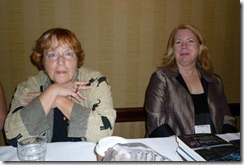
Deni Deitz and Pat Van Wie
Robert Gussin from Oceanview Publishing says they put out one book per month and have about 50 authors. They're looking for exciting, fast-paced stories in the mystery/suspense/thriller genres. He advises authors to build depth of character. Write truly what you know. They like credibility, i.e. a doctor who writes medical mysteries, a pilot who write books about airplanes, or a lawyer who writes courtroom dramas. Half the books they get are about Middle Eastern terrorists, so if you write one, it had better be different. They do hardcover and ebooks with a two book contract. The first book will later come out in trade paperback. About three books per month are going to audio. They take agented submissions only, unless you are previously traditionally published, you've met him at a conference, or you've heard him speak on a panel.
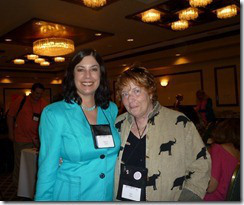
Nancy Cohen and Deni Dietz
All of my photos are available in the Sleuthfest 2012 Album on my Facebook Author Page. Please "Like" my page while you're there!








March 8, 2012
The Power of Publicity
The Power of Publicity, Part I
Sandra Balzo, Terrie Moran, Joanne Sinchuk, Jerry Healy, moderated by Deborah Sharp
The panelists first spoke about tips for getting noticed. Sandra advises authors to determine your audience and go there. For example, her series is set a coffee shop. So she's presented at coffee conferences, written an article in trade magazines, and done events at coffee houses.
Joanne, manager of Murder on the Beach mystery bookstore, suggests you start your publicity six months before publication date. Also six months before, begin networking, set up your website, and start participating on the social networks. Understand your audience and target your market. She cautions writers not to send glitter or confetti or chocolate in the mail to reviewers or booksellers. Also, don't ask every blogger out there if they'll give you a free interview spot.
It takes 3 to 5 hits to get noticed online. Terrie says to take advantage of opportunities you might not have anticipated. Always be nice. Join MWA and sisters in crime. Criminal element.com is a community website for fans of crime fiction with over 10,000 hits per day, so check this out.
Jerry said you should hit local newspapers. Offer to speak at high schools and libraries. And don't neglect local cable access TV.
Deborah suggested you develop a thick skin over signings where no one shows up.
And you should be syndicating your blog to other sites.
The Power of Publicity, Part 2
Joanne Campbell Slan, Nancy Cohen, Joan Hartwig, Jeffrey Marks, moderated by Linda Hengerer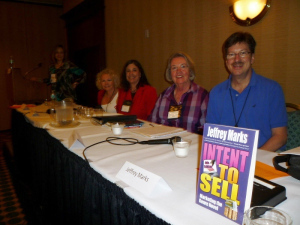
We discussed what has worked for us and what has not. Joan has done book fairs and festivals and local book clubs. Jeffrey Marks, who's written a book on marketing for writers called Intent to Sell, discussed social networking as a promotional tool. Joanne found it fun to run a party on her Facebook author page with guest author spots and giveaways.
Here are the highlights of my recent promo campaign. You can use it as a guideline for yours.
ADS
Romance Sells: $200 for an ad, sponsored by RWA to reach 6500 booksellers and librarians. Members only. http://www.rwanational.org
BLOGS
Personal Blog, Group Blogs, Blog Tour–Solicit Hosts; Determine Topics; Write Blogs; Publish Schedule; Prizes for Blog Commenters
BOOK CLUBS
Offer Discussion Questions for Book Clubs
BOOK TRAILER
CONFERENCES
CONTESTS and GIVEAWAYS
Goodreads and LibraryThing giveaways
$99 for a Contest on FreshFiction and you get to keep the list of entrants
Personal Blog and Website Monthly Contests
NEWSLETTER
I use http://www.verticalresponse.com for mass mailing email newsletters and have sign up widgets on my website and FB author page.
PRESS COVERAGE
With Shear Murder, my latest mystery release, I've been featured in Florida Weekly, Southern Writers Magazine, and The Island Reporter. These came about through social networking or by contacting people I noticed online.
PRINT MATERIALS
Bookmarks, flyers, postcards, Romance Trading Cards.
QR CODES
We discussed adding QR codes to business cards. People with smart phones can scan these and you can set them to go to your website, Amazon author page, or elsewhere.
REVIEWS
Determine Target Reviewers, Write Query Letters, Mail ARCs, Check for Reviews, Post Quotes on your Website; Thank Reviewer.
SOCIAL NETWORKING
Facebook, Twitter, Networked Blogs, Goodreads, Pinterest, Google +, and more. Does it sell books? Who knows? But it definitely gets your name out there.
SPEAKING ENGAGEMENTS & SIGNINGS
Set these up four to six months in advance. Post schedule on your website and elsewhere online.
SWAG
Magnets, pens, and other giveaways. It helps if they're related to your book in some manner.
WEBSITE
Make sure you add Buy links to your book when they become available. Refresh content often, and include some fun pages like recipes or bonus world building details for readers.
Coming Next: Editors Roundtable

March 7, 2012
Jeffery Deaver
Sleuthfest: Part 2
In his keynote luncheon speech on Friday, bestselling author Jeffery Deaver said, "Writing is a craft, and it can be largely taught." He writes multi-length thrillers in the crime genre. There are certain rules that he follows. 
Rule One: "Writing is a business. We are manufacturers of our product, not 'artistes'. We are professionals and meet our deadlines." We work with partners, who are publishers, booksellers, etc.
Rule Two: "We need a business model." Who is your audience? Write for your fans, to make them happy and to keep them turning pages.
Rule Three: Your book should move like lightning. What's going to happen next? Write a compelling book. Move the story forward. It shouldn't just be interesting but should cause sweaty palms.
Rule Four: We don't want the book to digress. For example, his tales move so fast that there's no time for a romantic interlude.
Rule Five: Avoid "give me a break" moments, or things that are illogical or convenient excuses.
Rule Six: Do not have ambiguous endings. Have a definite resolution. Jeffery prefers happy endings for his stories.
Rule Seven: Make your characters real and give them depth. The good guy should have flaws and the bad guy should have niceties.
Rule Eight: We rewrite. Jeffery writes a first draft quickly and then rewrites.
Where do his ideas come from? "I look for an idea that will scare you and keep you turning pages." He does an outline and research first.
What the fans think is more important than reviews. Find out what people are saying about your book. Jeffery prefers to keep the gore off-camera and to focus on the emotional component of suspense.
<><><>
Disclaimer: Any errors in interpretation or transcription are mine.
Coming Next: The Power of Publicity








March 5, 2012
Sleuthfest: Part 1
SleuthFest Orlando 2012
I had a great time at Sleuthfest held in Orlando this year. Attendance was fabulous and everyone was friendly and eager to make new friends. The Royal Plaza worked out fine, just minutes from Downtown Disney. Aside from speaking on three panels, I attended several sessions that I will describe for you here. Day 1 began on Thursday with a special fee and workshops for aspiring authors. You could also sign up for evening events, but since we have a condo in the area, I didn't partake of the dinner opportunities except for the final night. So beginning on Friday, here is a summary of what I learned. Any errors in interpretation or transcription are mine.
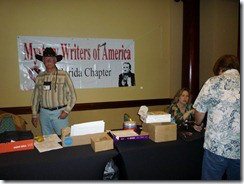
Registration Desk
THE PLOT THICKENS with Keith Thomson, Elizabeth Hand, Chris Grabenstein (moderator), Michael Wiley, Maris Soule, and John Gilstrap.
Chris uses a paradigm for screenwriters. Consider a two hour movie. Plot Point 1 is where a twist turns the film in another direction. It occurs about 30 minutes in. Act 2 is midway, at 60 minutes. Then there's another Plot Twist at 90 minutes. He used Sister Act with Whoopie Goldberg as an example. She's a nightclub singer who confronts her lover only to witness him getting killed by the Mob. The FBI puts her into witness protection at a convent, which is Plot Point 1. During the first half, she hates the place and wants to leave. Midway, she goes out with the nuns and has a good time. Act 2, Part 2—She's making the best of her situation and teaching the nuns to sing in the choir. This section ends with Plot Point 2: The mobsters see her on TV. Act 3 is a chase scene where the thugs are after her. For a 50,000 word book, the plot points would come at 12,500, 25,000, and 37,500 and then a final twist at the end.
John outlines the beginning, middle, and end. He includes character development in his plotting. Changes to main characters occur slowly over the course of a multi-book canvas. In a hostage rescue tale, the kidnap victim might be the one who has a full story arc. The bad guys also need to be well motivated. What do they want? What do they have to hide? What's at stake in the big picture?
Keith says to "concentrate on one or two fundamentals." Get a character up a tree and then figure out how to get him down.
Michael writes a PI series set in Chicago. He devises strong beginnings and endings. Michael explained three types of plot:
1. Take two seemingly unrelated story threads and weave them together.
2. Have historical and present day dimensions that relate to each other later on.
3. Go from Point A to Point Z without any secondary story. A hostage situation or a bomb about to explode would go here. This is often the choice for thrillers.
He sets up his conflict within the first few pages rather than choosing to build it slowly. Within the first fifty pages, the reader may suspect who is the bad guy but then doubts are raised with twists and turns. Two-thirds of the way through, there's a crisis followed by a chase. At the end is a final twist, so the bad guy might turn out to be someone else.
Elizabeth comes from a playwriting background. "Everything should come from character." She doesn't outline. She'll create a memorable character and follow that character wherever he goes. She's drawn to disturbing landscapes. "What could possibly go wrong here?" Find a place where things can happen and then put your character there. A cascade of reactions follows. Elizabeth may have two endings in mind and not know until she gets there which way the character will go. That brings an element of surprise to the story.
Maris, an art major and teacher, says "You pick up plotting from the act of having read." She began her career in romance writing and had to write synopses as a sales tool. So she knows the beginning and end but the "middle can become the hairy thing." She recommends Debra Dixon's book on GMC: Goal, Motivation & Conflict and Christopher Vogler's The Writer's Journey: Mythic Structures for Writers.
Chris recommends Story: Substance, Structure, Style, and the Principles of Screenwriting by Robert McKee. If a scene starts positive, he says, it should end negative—and vice versa.
FAMILY TIES with
Hank Phillippi Ryan (moderator),
Julie Compton,
Reed Farrel Coleman,
Patricia Gussin,
Do
nna Andrews, and Nancy J. Cohen.
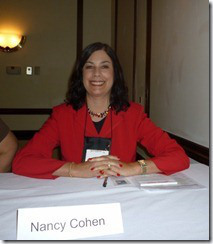
I participated on this panel. We discussed the importance of family ties in our mysteries, and I added how this factor motivates the characters in my romances as well. It doesn't matter if the story is set in modern day times, a historical setting, or outer space. Family is what matters to our protagonists.
Our stories center around relationships. In the mystery/suspense genre, the focus may be on the criminal's background and what made him the way he is, the victim's family and how the crime affects them, or the relationships among the suspects. Plus, giving your sleuth a dynamic relationship with family and friends will round her out and make her more real.
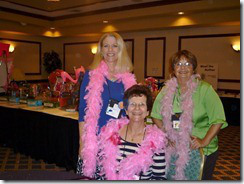
Vicki Landis, Gregg Brickman, Ann Meier, the Boa Ladies selling raffle tickets.
Coming Next: Bestselling Author Jeffery Deaver's Luncheon Speech








March 2, 2012
Venetian Pool
The Venetian Pool in Coral Gables, Florida is one of those gems you discover on the road to research. Marla Shore, my intrepid hairdresser sleuth, goes here in Shear Murder to interview a suspect. I'd never been here before, not even in the years when I lived and worked in the area. So imagine my delightful surprise when I found this historical site nestled in the city. 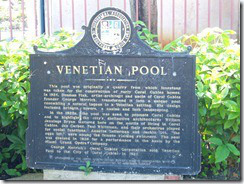
I'll let you explore along with Marla as she hastens inside, looking for Griff Beasley. Griff is a magazine photographer who was at her friend Jill's wedding. Marla was a bridesmaid when she discovered the matron of honor dead under the cake table. It's possible Griff's pictures might shed some light on the crime. He's here to take photos at a fund-raiser event.
<><><>
[Marla] breezed across a small bridge with salmon-colored grillwork toward a Venetian-style building. One short flight of stone steps led downward toward clusters of crotons and a grotto-like space beyond. Another staircase rose into a tower.
She descended to the ground level, ducking her head beneath an arch to enter a reception area with an unmanned admission desk. No doubt she'd find Griff mingling among the revelers. Not a soul lingered indoors here.
The main entrance segued into an anteroom lined with blue-colored tiles and boasting a central fountain and historic photos mounted on the walls. Formed from a limestone quarry in 1924, the pool was listed in the National Register of Historic Places. It held 820,000 gallons of water from a natural spring.
Impressed, Marla thought how lucky the community was to have this facility for its residents. It reminded her of the swim clubs up north where she grew up.
Past another stone archway, she stepped into an open-air courtyard set with tables and chairs. Couples stood around laughing and sipping champagne, while waiters strolled by carrying trays of hors d'oeuvres. Marla spared a glance at the barracks-like buildings bordering the courtyard. A meager sign read café on one door, no doubt leading to a concession stand during the day.
Directing her attention toward the grotto-like pool, she followed the tile path to a covered loggia where wood beams crisscrossed overhead. It faced the water on one side and the courtyard on the other. Elbowing her way through the partygoers, she didn't see Griff anywhere. 
Across the water's emerald expanse, an enormous waterfall gushed into the lagoon. The roar of cascading water resounded along with the chatter of guests and the clink of glasses. She spotted an empty lifeguard chair shaded by an umbrella in the middle of a cobblestone bridge. Behind it looked to be a coral cave. Could Griff be in there? 
She made her way over and peered inside. A bunch of nattily dressed folks sat on wood benches while balancing plates of food. No sign of Griff. You'd think he'd be circulating and snapping pictures, unless he already finished his job here.
"Excuse me, have you seen a photographer around?" she asked a patron. "He works for Boca Style Magazine."
The woman, surveying Marla's simple skirt and knit top, lifted her nose. "I saw him last by the beach, dear. Tell him I'd be happy to pose for a picture, will you?"
Marla didn't deign to answer. Instead, she strode toward a stretch of sandy beach facing the cool emerald lagoon fringed with palm trees and dotted with lampposts that looked like they came straight from Venice, painted a whimsical apricot and melon.
Some guests sat on lounge chairs, but Griff wasn't among them. Her gaze followed the pathway as it rimmed the pool, but she didn't spot his tall figure. She must have missed him.
Disappointed, Marla turned back while rustling her car keys from her purse. She'd have to drive to the Biltmore after all. When the keys slipped through her fingers, she crouched to retrieve them from the grass. Her gaze fell upon a partially hidden grotto through a stone archway covered by a leafy vine. 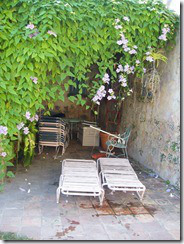
Stacked lounge chairs, pool cleaning tools, and a huge ceramic planter lay inside the gloomy interior . . . from which a man was stumbling toward her. She straightened quickly.
"Marla, is that you?"
Good God, it was Griff! He had a dazed look on his face as she rushed over.
"What happened?" She noted a nasty bruise on his temple.
"I dunno. Must have hit my head." He touched the spot. "Ouch, that hurts."
"Are you dizzy?"
"I'll be okay."
"This arch is awfully low. Did you forget to duck?"
"Nope, I heard somebody call my name from inside. That's the last thing I remember, babe." His face flooded with awareness. "My camera . . . do you see it?"
"Just a minute. It's too dark in there." Withdrawing a penlight from her purse, Marla shone it around the grotto. "Here it is." She pounced on a case lying in the corner.
Griff grabbed it from her and rummaged through the contents. "Yo, everything seems to be intact." He patted his pocket. "My wallet is still here. Couldn't have been a thief."
"Maybe the intent wasn't to steal anything."
Shear Murder by Nancy J. Cohen
Who knew weddings could be murder? Hairstylist Marla Shore is weeks away from becoming a bride herself when she walks down the aisle as a bridesmaid at her friend Jill's ceremony. Things take a turn for the worse when the matron of honor ends up dead, the cake knife in her chest. Now what will they use to cut the cake?








February 26, 2012
Crime Writers Research
While researching my mysteries, I often need information that you can't go around asking friends. Things like, what kind of poison will kill someone right away and is easily obtainable? How can I stage a crime scene by hanging to make it look like a suicide? What would tip off the cops that it's foul play? Or, if a detective becomes a suspect in a murder case, is he removed from action? Often I need specific answers to help me set my scenes with as much authenticity as possible. 
Fortunately, mystery writers have a range of resources available besides your friendly cop on the local force. These are some of the sites where you can get this type of concrete information. Check out the links; they'll lead you to more informational websites and blogs. Others are listserves you can join. Once you're on the loop, throw out whatever question you need answered. Chances are someone will be qualified to respond.
Please share here which places you find useful in your crime scene research. And good hunting!
Crime Scene Writers at Yahoo Groups, http://tech.groups.yahoo.com/group/crimescenewriter
To subscribe: crimescenewriter-subscribe@yahoogroups.com
In Reference to Murder, http://www.inreferencetomurder.com/
Lee Lofland, veteran police investigator, http://www.leelofland.com/wordpress/
Mystery Writers of America, http://www.mysterywriters.org/
The Writers Forensic Blog by D.P. Lyle, MD, http://writersforensicsblog.wordpress.com/
Sisters in Crime, http://www.sistersincrime.org/
<><><>
All commenters during my February blog tour will be entered into a drawing for signed copies of Perish by Pedicure and Killer Knots. Only three more days to enter! Be sure to stop by:
Tuesday, February 28, Killer Characters, Topic: Hair Care Q&A with Marla Shore!








February 22, 2012
Here's another promotional tool that will drive you crazy. I've recently joined Pinterest, where you pin up pictures online that can relate to any themes you choose, such as your books, your characters, the locations in your story, or your life in general. This acts as an online pinboard collection that other folks can follow. If someone spots a photo on my board they like, they can share it. You tell what the picture means and people can comment on it. You create your boards and give each one a name. It's good to check out the boards of someone you know first to get an idea of how it works and what themes might appeal to you.
When you install the Pin It button on your browser, it allows you to pin a picture whenever you go to a website with pin-able photos. The program automatically attributes the source. Still, I think you should be wary of copyright issues. It may not be okay to just lift any photos you like and stick them on your boards.
Here's one tip for writers that's been useful. Instead of uploading your book cover photos from your computer (like I did for my first two), go to the buy page at an online bookstore and use that photo. Then the attributable link will take people there.
Learning how to use Pinterest is definitely a time sink. But with nearly five million users, it can be a great promotional opportunity. People seem to get hooked on it once they get started. It's a way to let readers into your life and to showcase those things you find meaningful and fun. Oh, and you have to request an invitation to join or ask a friend who's a member to invite you. Then you register using your Facebook or Twitter account.
Check out these sites for more information:
http://writetype.blogspot.com/2012/02/pinterest-5-best-practices-for-writers.html
http://www.authormedia.com/2012/02/01/3-ways-authors-can-use-pinterest-guilt-free/
http://www.authormedia.com/2012/02/02/set-up-your-author-pinterest-profile-in-10-easy-steps/
http://www.authorems.com/2012/pinterest/
http://savvybookwriters.wordpress.com/2012/01/29/how-can-pinterest-increase-your-book-sales/
http://www.copyblogger.com/pinterest-marketing/
http://greekgeek.hubpages.com/hub/Is-Pinterest-a-Haven-for-Copyright-Violations
http://blog.hubpages.com/2012/02/using-pinterest-for-hubpages/
http://blog.verticalresponse.com/verticalresponse_blog/2012/02/like-it-pin-it-sell-it-why-pinterest-matters-for-your-business.html
So do any of you already participate in Pinterest? Or would you do it now that you're aware of this site?








February 19, 2012
Struggling with a Synopsis
Before I begin writing the story, I write my synopsis. This will act as my writing guideline. See my Feb. 6 blog on the plotting process. With each draft of the synopsis, I add more depth, consistency, and motivation. However, I'm now stuck on two points for my next mystery.
The Crime Scene: My working title is Hanging by a Hair. So I want my victim to be hanged. The problems are two-fold. He's bigger and stronger than the killer. And where in a house can I hang him? I searched through my file of newspaper clippings and came up with one that tells of a woman hanged by a workman on a shower rod. A shower rod? Seems to me it would fall down if the victim is heavy. Where else in a house would this work? And wouldn't the killer have to incapacitate the person first and then string him up? How would this be possible if the victim weighs a lot?
Once I figure out these details, I'll have the killer write a confession scene. Then I will know, before I begin writing, what the outcome is of my story. When I get to the confrontation between killer and sleuth in the book, I'll just slide in this dialogue. My next step is to research on the Internet to see if I can find any relevant news stories that may help spark ideas. If the killer incapacitates the victim first, how is this done? Hitting him on the head is easy, but it's too obvious if you want the hanging to appear as a suicide. Say the killer poisons the vic. What type of poison? How do they get hold of it? Does it act immediately? Does vomiting/diarrhea occur before death, causing a messy scene?
See how you have to think things through. Then the writer has to figure out what clues are left at the scene. 
The Suspects: I'm pretty clear on most of my suspects, having worked through their motives a couple of times and with my critique partners' input. But I am still having one problem. The victim discovers a secret. He tells Suspect A, who tells Suspect B. Meanwhile, the victim also tells Suspect C who pays him to keep quiet. But Suspect C is afraid Suspect A will talk to the authorities. So he threatens her to ensure her silence. Okay, he threatens her with what? What does she want to keep hidden?
She's a professor at a local university. So I've come up with a list of possibilities: Plagiarism? Falsifying credentials? Seducing a younger student? Making up reference material to support a recent publication? Accepting bribes in return for good grades?
Whichever one I choose, how would Suspect C—a real estate developer—find out about it?
I decide Suspect A is a single mother with two college age kids. She needs to keep her job to put them through school. Suspect C threatens her with exposure in a manner that might get her fired. Which one of the above might she have done? Does Suspect C threaten her before or after she tells Suspect B? And why does she tell that person? Because she holds a grudge against the victim, and she knows Suspect C will act on her revelation without getting her involved. So basically, I have to determine what secret she's hiding and how Suspect C finds out about it. Sound complicated? I'm confusing myself by even discussing it here. 
Fortunately, I'm not on deadline, so I can take as long as necessary to work out these points. I'll want my synopsis to read smoothly, follow in a logical manner, and include personal elements in the sleuth's life. In a cozy mystery, the story is more about the sleuth than the victim, the aftermath of murder, and the criminal's psyche, which may be the focus of a serious crime novel. In my stories, the personal relationships among the suspects and how they impact the sleuth are what matter, but still the details have to be accurate and plausible.








February 16, 2012
Literary Tea
LITERARY TEA with Author Nancy J. Cohen
Friday, February 17 @ 7 PM
"Shear Murder"
South Florida Stylist, Marla Shore, is back and attending the wedding of her friend . The matron of honor must have stood in the way of something because she is found at the reception dead beneath the cake table. With her own nuptials only weeks away, Marla becomes embroiled in a series of secrets from the past that threaten her own safety.
Well Read Books, South Harbor Plaza, 1374 SE 17th Street, Fort Lauderdale, FL 33316
CALL 954-467-8878 FOR FOR DIRECTIONS OR WITH ?'s
Refreshments from the 11th Street Annex
While at the tea, enjoy the photography installation by Clay Wieland.
<><><>
I'm guest blogging today on Patricia Stoltey's site about Obsessions and Orchids, or How to make a character more interesting. Leave a comment for a chance to win signed copies of Killer Knots and Perish by Pedicure in my February drawing!








Nancy's Notes from Florida
- Nancy J. Cohen's profile
- 667 followers


